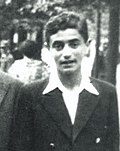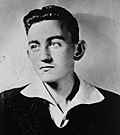Echoes of Defiance
An academic exploration of the Żydowska Organizacja Bojowa (ŻOB), the Jewish Combat Organization, detailing its formation, resistance efforts, and pivotal role in the Warsaw Ghetto Uprising during World War II.
Begin Exploration 👇 View Gallery 🖼️Dive in with Flashcard Learning!
🎮 Play the Wiki2Web Clarity Challenge Game🎮
Introduction
The Jewish Combat Organization (ŻOB)
The Żydowska Organizacja Bojowa (ŻOB), commonly translated as the Jewish Combat Organization or Jewish Fighting Organization, was a pivotal World War II resistance movement operating within Nazi-occupied Poland. Emerging from the consolidation of five distinct Jewish political and youth organizations—Hashomer Hatzair, the Polish Workers' Party, Habonim Dror, Poale Zion, and the Bund—the ŻOB became the central force behind the organization and execution of the Warsaw Ghetto Uprising.[1][2] Beyond this monumental event, the ŻOB actively participated in numerous other acts of resistance against the occupying forces.[3]
Context of Occupation
Operating under the brutal regime of Nazi Germany in occupied Poland, the ŻOB represented a determined effort by Jewish communities to resist systematic persecution and annihilation. The organization's formation and actions were directly influenced by the escalating deportations and atrocities carried out by the Nazi regime, particularly the devastating Grossaktion Warsaw which commenced in July 1942.[4]
Formation and Early Resistance
Genesis of the ŻOB
The ŻOB was formally established on July 28, 1942, a mere six days after the commencement of the Grossaktion Warsaw. This large-scale operation, orchestrated by SS General Jürgen Stroop, aimed at the mass deportation of Jews from Warsaw, with the stated intent of their resettlement in the East. This brutal campaign, lasting until September 12, 1942, drastically reduced the Jewish population of Warsaw from approximately 400,000 to between 55,000 and 60,000, with the majority being sent to the Treblinka extermination camp.[5]
Foresight of Youth Groups
The constituent youth groups, including Hashomer Hatzair and Dror, possessed a prescient understanding of the Nazi regime's genocidal intentions. Unlike many older Jewish leaders who harbored doubts or hoped for less dire outcomes, these younger organizations recognized the existential threat and began transitioning their focus from cultural and educational activities to armed self-defense and eventual armed struggle.[6] A declaration from Hashomer Hatzair three months prior to the deportations starkly stated: "We know that Hitler's system of murder, slaughter and robbery leads steadily to a dead end and the destruction of the Jews."[7]
Initial Disagreements
The proposal for an armed self-defense organization, put forth by left-wing Zionist youth groups like Hashomer Hatzair and Dror in March 1942, initially met resistance. The Jewish Labour Bund expressed skepticism, believing such an endeavor would fail without the support of the broader Polish resistance. Others dismissed the immediate threat of deportation, arguing that armed resistance would inevitably provoke severe German reprisals against the entire Jewish population.[8][9]
Subordination and Support
By November 1942, the ŻOB formally integrated into and subordinated its operations to the High Command of the Armia Krajowa (Home Army). In return, the Home Army provided crucial support in the form of weapons, ammunition, and training, with the initial arms shipment occurring in December 1942.[10] Regrettably, the organization also faced internal threats from Jewish collaborators, whom the Nazis referred to as the Society of Free Jews.[11]
Resistance During Deportations
Confronting the Second Deportation
On January 18, 1943, the Nazis initiated a second wave of deportations. A contingent of ŻOB fighters deliberately joined the ranks of those being rounded up. Upon a prearranged signal, they broke formation, engaging the German guards with small arms fire. This act of defiance caused the deportation column to scatter, and news of the coordinated action by the ŻOB and the Jewish Military Union (ŻZW) rapidly disseminated throughout the ghetto. Consequently, the Nazis managed to deport only approximately 5,000 to 6,000 Jews during this four-day period.[5]
A Ghetto's Perception of Victory
The successful resistance during the January deportations was perceived by the remaining ghetto inhabitants as a significant victory. However, historian Israel Gutman, himself a member of the ŻOB, noted that the full extent of the German plan was not yet understood by the Jewish population. He concluded that these deportations nonetheless had a "decisive influence on the ghetto's last months," signaling a shift towards open confrontation.[5]
The Warsaw Ghetto Uprising
The Final Deportation and Uprising
The final deportation commenced on the eve of Passover, April 19, 1943. The streets of the ghetto were eerily silent as the majority of the remaining 30,000 Jews hid in meticulously prepared bunkers, including the ŻOB's headquarters at Ulica Miła 18. These shelters, some equipped with electricity and running water, offered no escape routes.
As German forces entered the ghetto, they were met with fierce armed resistance. Fighters launched attacks from elevated positions, utilizing guerrilla tactics that exploited the element of surprise and provided a tactical advantage. However, the systematic burning of ghetto buildings by the Germans forced the combatants into the underground bunkers, where the accumulating smoke and heat created suffocating death traps.
Sacrifice and Suppression
On May 8, 1943, in the bunker at 18 Miła Street, Jurek Wilner urged fighters to commit mass suicide rather than surrender. Lutek Rotblat reportedly initiated this tragic act by shooting his mother and then himself. Most members of the Combat Organization, including Commander Mordechai Anielewicz, perished in this bunker.[12]
By May 16, 1943, SS Police General Jürgen Stroop declared the Grossaktion complete. In a symbolic act of destruction, Warsaw's Great Synagogue was razed. The ghetto was systematically destroyed, and the remnants of the uprising were brutally suppressed.[5]
Epilogue and Legacy
Survival and Continued Resistance
Despite the destruction of the ghetto, pockets of Jewish survivors persisted in underground bunkers. During the final months of the ghetto's existence, an estimated 20,000 Jews escaped to the "Aryan" side of Warsaw. Some of these survivors, including prominent ŻOB leaders like Kazik Ratajzer (Simcha Rotem), Zivia Lubetkin, Yitzhak Zuckerman, and Marek Edelman, went on to participate in the broader Warsaw Uprising of 1944 against the Nazis.[5]
Enduring Movements
While many members and leaders of the youth movements perished during the Warsaw Ghetto Uprising, the Zionist and non-Zionist youth movements themselves endured. Remnants of groups like Hashomer Hatzair, Habonim Dror, the Jewish Labour Bund's SKIF, and Betar continue to operate internationally, preserving their legacies and educational missions in various countries.
Gallery
-
 Mordechai Anielewicz
Mordechai Anielewicz -
 Mira Fuchrer
Mira Fuchrer -
.jpg/120px-Yitzhak_Zukermann%2C_during_his_testimony_at_the_trial_of_Nazi_war_criminal_Adolf_Eichmann_D408-073_(cropped).jpg) Yitzhak Zukermann
Yitzhak Zukermann -
 Zivia Lubetkin
Zivia Lubetkin -
 Marek Edelman
Marek Edelman -
 Izrael Kanal
Izrael Kanal -
 Itzhak Katzenelson
Itzhak Katzenelson -
 Michael Klepfisz
Michael Klepfisz -
.jpg/120px-Vladka_Meed_(2005).jpg) Vladka Meed
Vladka Meed -
Symcha Ratajzer
-
 Yitzhak Sukenik
Yitzhak Sukenik -
![Dawid Wdowiński [ZZW]](https://upload.wikimedia.org/wikipedia/commons/thumb/8/84/Dawid_Wdowi%C5%84ski.jpg/120px-Dawid_Wdowi%C5%84ski.jpg) Dawid Wdowiński [ZZW]
Dawid Wdowiński [ZZW]
Teacher's Corner
Edit and Print this course in the Wiki2Web Teacher Studio

Click here to open the "Jewish Combat Organization" Wiki2Web Studio curriculum kit
Use the free Wiki2web Studio to generate printable flashcards, worksheets, exams, and export your materials as a web page or an interactive game.
True or False?
Test Your Knowledge!
Gamer's Corner
Are you ready for the Wiki2Web Clarity Challenge?

Unlock the mystery image and prove your knowledge by earning trophies. This simple game is addictively fun and is a great way to learn!
Play now
References
References
- Call to Armed Self-Defense, from Ha-Shomer Ha-Zair newspaper in the Warsaw Underground Jutrznia ("Dawn"), March 28, 1942.
Feedback & Support
To report an issue with this page, or to find out ways to support the mission, please click here.
Disclaimer
Historical Context and Accuracy
This document has been generated by an Artificial Intelligence, drawing information exclusively from the provided source text, which is based on a Wikipedia article. It is intended for educational and informational purposes, offering an academic perspective on the Jewish Combat Organization (ŻOB) and its role in World War II.
Historical Sensitivity Advisory: The subject matter involves sensitive historical events related to the Holocaust. While efforts have been made to present the information accurately based on the source, historical accounts can be complex and subject to interpretation. This content is not a substitute for comprehensive historical scholarship or direct engagement with primary source materials.
The creators of this page are not responsible for any errors or omissions in the source material or for any actions taken based on the information provided herein. Users are encouraged to consult multiple reputable historical sources for a complete understanding of this critical period.
.JPG/120px-Symcha_Ratajzer_i_Agnieszka_Arnold_052_(cropped).JPG)